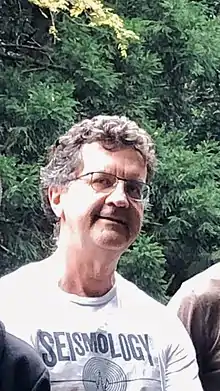Gregory C. Beroza | |
|---|---|
 Greg in Japan, 2019 | |
| Born | October 10, 1959 |
| Other names | Greg |
| Citizenship | American |
| Alma mater | 1989 PhD Massachusetts Institute of Technology 1982 B.S UCSC |
| Scientific career | |
| Fields | Seismology, Geophysics |
| Institutions | Stanford University |
| Doctoral advisor | Thomas H. Jordan |
Gregory C. Beroza (born October 10, 1959) is a seismologist and the Wayne Loel Professor of Earth Sciences at Stanford University.[1] He is also the Co-Director of the Southern California Earthquake Center.[2] He was elected to the fellow of American Geophysical Union in 2008.[3] He was elected a member of the National Academy of Sciences in 2022.[4]
Education and early career
Gregory obtained his Bachelor's degree from University of California, Santa Cruz in 1982 and his PhD degree from MIT in 1989. He became a faculty in Stanford geophysics in 1990 after being a post-doc researcher at MIT.[5]
Research
Fingerprint And Similarity Thresholding (FAST)[6][7]
The Fingerprint And Similarity Thresholding algorithm was developed by Beroza group to "efficiently detect previously overlooked microquakes".[7] This method can analyze week-long seismic information in less than 2 hours, 140 times faster than the traditional autocorrelation method. Furthermore, the new technique would help better monitor and categorize earthquakes.
Human-induced Earthquakes[8][9]
Greg's team measured stress drops in a number of human-induced and natural earthquakes in central US. They found the ground motions in induced and natural earthquakes are largely the same. The results suggest the ground motion prediction equations can be also applied to human-induced earthquakes and can be used to reduce the earthquake hazards in central US.
Awards
Partial bibliography
- Beroza, G. C., & Jordan, T. H. (1991). Rupture histories of the 1934 and 1966 Parkfield, California, earthquakes: a test of the characteristic earthquake hypothesis. Stanford, CA: The University. OCLC 32080287
- Beroza, G. C. (1995). Seismic source modeling (95RG00736). Reviews of Geophysics. 33, 299. ISSN 8755-1209 OCLC 89600682
- Beroza, G. C. (1997). "Earthquake Seismology". Geotimes. 42 (2), 53. ISSN 0016-8556 OCLC 87304084
- Beroza, G. C. (2003). Fault segmentation and possible pore fluid effects in the 1992 Landers, California aftershock sequence. Stanford, CA: Dept. of Geophysics, Stanford University. OCLC 57190036
- Beroza, G. C., & Bokelmann, G. H. R. (2002). Constraints on crustal and fault-zone rheology from earthquake mechanisms. Stanford, CA: Dept. of Geophysics, Stanford University. OCLC 57244579
See also
References
- ↑ "Prof Gregory C. Beroza". Stanford University. Retrieved 12 November 2016.
- ↑ "SCEC Leadership".
- ↑ "Induced Earthquakes in the 21st Century By Dr. Gregory Beroza, Stanford University, Berkeley Seismological Laboratory - Lawson Lecture". www.linkedin.com. Retrieved 2022-01-13.
- ↑ "2022 NAS Election".
- 1 2 3 "Greg Beroza CV".
- ↑ Yoon, Clara E.; O’Reilly, Ossian; Bergen, Karianne J.; Beroza, Gregory C. (2015). "Earthquake detection through computationally efficient similarity search". Science Advances. 1 (11): e1501057. Bibcode:2015SciA....1E1057Y. doi:10.1126/sciadv.1501057. PMC 4672764. PMID 26665176.
- 1 2 Matchar, Emily. "Stanford Scientists Create an Algorithm That Is the "Shazam" For Earthquakes". Smithsonian Magazine. Retrieved 2022-01-13.
- ↑ "Shake it up: Human-induced and natural earthquakes in central U.S. are 'inherently similar'". University of Michigan News. 2017-08-02. Retrieved 2022-01-13.
- ↑ Huang, Yihe; Ellsworth, William L.; Beroza, Gregory C. (2017). "Stress drops of induced and tectonic earthquakes in the central United States are indistinguishable". Science Advances. 3 (8): e1700772. Bibcode:2017SciA....3E0772H. doi:10.1126/sciadv.1700772. PMC 5540254. PMID 28782040.
- ↑ "Internationally leading seismologist Prof. Dr. Gregory Beroza at GFZ". www.gfz-potsdam.de. Retrieved 2022-01-13.
- ↑ Lozier, Susan; Myles, Latoya (2021-09-10). "2021 AGU Section Awardees and Named Lecturers". Eos. 102. doi:10.1029/2021eo163068. S2CID 239255548. Retrieved 2022-01-13.